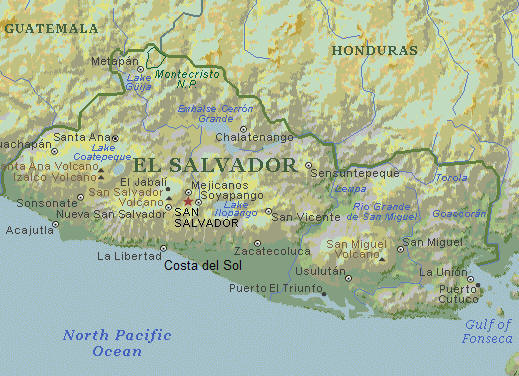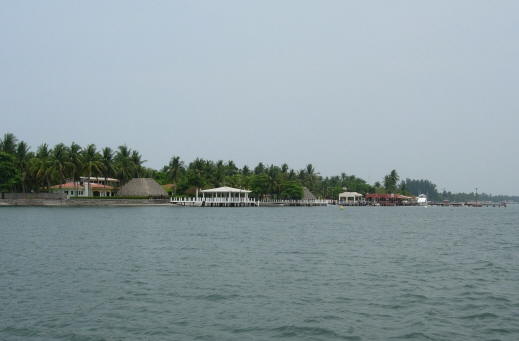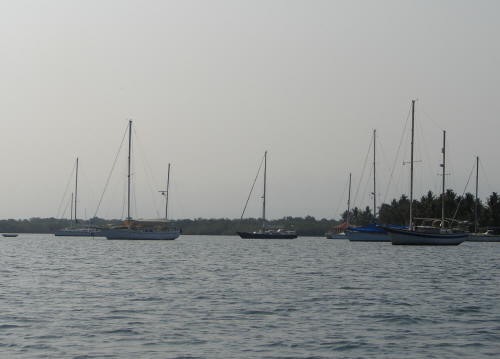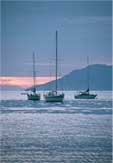
Logbook: El Salvador - San Salvador
& Parque Nacional El Impossible (May 2006)
El Salvador
El Salvador is the smallest country in Central America. At just over 8,000 square miles, it's about the size of the state of New Hampshire. Conversely, with a population of 6.3 million, it is the most densely populated country in Central America.
El Salvador was embroiled in a bitter civil war from 1980 to 1992. In 1992, the feuding parties signed a peace treaty, and the country has put the war behind them and focused on making forward progress. El Salvador has raised itself from the wreckage of civil war to near the top of Central America's economic ladder; however, poverty and unemployment still persist in rural areas. In addition to the war, El Salvador has faced natural disasters, including massive earthquakes in 2001 which killed more than 800 people and left over 100,000 homeless.
After spending three years in Mexico, when we arrived in El Salvador, we couldn't help but make some comparisons. One of the first things we noticed is that Salvadoran people looked different than the Mexicans. Many of the Mexican people we met were descendents of the indigenous tribes. Due to brutal repression in earlier times, only 1% of El Salvador's population is indigenous. The vast majority are mestizo (a mixture of Spanish and indigenous). Although most have dark hair, we occasionally see a Salvadoran with lighter eyes (usually green or hazel).
Another difference we noticed is that although Salvadorans speak Spanish, they use different expressions than Mexicans. For example, when we greeted people in Mexico, we would say "Hola" (Hello), "Buenos Dias" (Good Morning), "Buenas Tardes" (Good Afternoon) or "Buenas Noches" (Good Evening). Salvadorans rarely use "Hola." Here, the usual greeting is simply "Buenas" - with no Dias, Tardes or Noches accompanying it. That makes it easier for those of us who cannot remember what time of day it is. Another expression we hear a lot is "Ba!" We never heard that in Mexico, and had no idea what it meant. We found out it means "OK" or "fine."
Other interesting tidbits:
- The U.S. dollar is the official currency in El Salvador (adopted in January 2001). ATM's here spit out $10 bills instead of the $20's we get in the States. The paper currency we get in El Salvador, however, is usually much dirtier and worn out than that used in the U.S.
- Pupusas are to El Salvador as tacos are to Mexico. A Pupusa is like a thick cornmeal pita pocket stuffed with a variety of items - normally cheese, beans, chicharron (fried pork fat) or any combination of them. We can also get shrimp pupusas here on the coast. Pupusas are served with "curtido" - a mixture of pickled cabbage and carrots - and a light tomato salsa.
- El Salvador boasts the best roads in Central America. Most of the main highways were rebuilt/repaved after the war.
| Slip Away is moored in Estero de Jaltepeque near Costa del Sol ("Sun Coast") in El Salvador. Costa del Sol is a peninsula with the ocean on the outside and an estero (or lagoon) on the inside. The estero has a narrow opening to the ocean, but it is protected from ocean swell. Costa del Sol is mostly rural, but it is also a resort area with some hotels and private homes along the beach. The hotels and private homes are much smaller in size and number than what one would find on U.S. beaches - there are no high rises here. The Hotel Bahia del Sol invites boaters to use their facilities (dinghy dock, pool, showers, internet) for a nominal fee. Since the weather here is hot and humid, and the estero water isn't very clean for swimming, we make good use of their pool. |
|
Other than the hotels and a few small restaurants, there's not much in Costa del Sol. The local tiendas sell only the basics - eggs, some dry goods and a few veggies (usually tomatoes, potatoes and onions). To do real grocery shopping, we need to take a bus to a larger town. For groceries, we usually go to Zacatecoluca (about 1¼ hours and $1.50 per person each way). "Zacate" has an open-air mercado for fruits and veggies and two good grocery stores, so we can find most everything there. We can also go by dinghy to La Herradura (about 20 minutes), where they have an open-air mercado twice a week for fruits and veggies, but they don't have a grocery store there.
| The local buses in El Salvador (and throughout Central America) are old U.S. school buses, most of which have been repainted in lots of bright colors. People in the rural areas generally do not own cars, so they travel by bus. The buses are commonly referred to as "chicken" buses because occasionally a rider comes on board with live chickens. Friends of ours have also wondered if perhaps these buses are called chicken buses because of the daredevil bus drivers. On more than one occasion, Jan has closed her eyes when the bus driver passed another vehicle on a blind curve. |
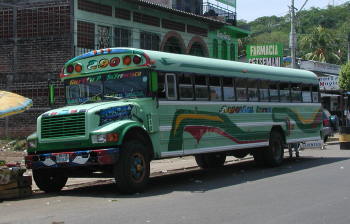 |
Riding the local bus in El Salvador can be an adventure. (We sometimes have to remind ourselves that attitude is the difference between an ordeal and an adventure.) First of all, the buses can get really crowded. We've been on buses with three people squeezed in a seat and others standing in the aisle. Since we're both tall and many of the Salvadorans are fairly round, it's not necessarily comfortable. Fortunately, Salvadorans are for the most part happy and friendly people, and everyone seems to go with the flow. Additionally, most of the bus drivers are young men who like to listen to their music with the volume turned way up, aided by 1000 watt amplifiers. One bus we rode had two TV's and showed salsa videos, which could have been quite entertaining if our ear drums had not been rattling from the volume level. Along the bus routes, at various stops, vendors come on board. Food and drink are popular items - pupusas, candy, breads, water, sodas ("gaseosas") and other drinks. Some of the drinks are sold in plastic bags - sometimes they come with a straw, but if not, one just bites off a corner and drinks it that way. Unfortunately, after the food or drink is consumed, the waste paper or plastic is usually thrown out the window. (It goes without saying that litter is a problem here.) In addition to food, sometimes vendors come on board selling and extolling the virtues of herbal remedies. Fortunately, we can use the "no comprendo" excuse when they ask if we want to buy some. An added feature of riding the bus from a rural area like Costa del Sol is that the bus gets to dodge cows, pigs and other animals that wander into the road. It's not unusual to encounter a whole herd of cows in the road. The herder is often on a bicycle.
We've read and been advised by others that when traveling in El Salvador and Central America, we should dress appropriately. Even at the coast when Fahrenheit temps and humidity percentages are approaching 100, Jan is supposed to wear either long pants or a long skirt (at least below the knee). Rich can get away with wearing shorts, although when he does, the local people sometimes stare. (But then, we're not sure if they are staring because of Rich's shorts or our fair hair and skin.) Although covering one's legs is the unwritten rule for women, it seems to be OK to bare one's midriff or show off cleavage. Given the Salvadorans' love affair with pupusas, some might achieve a better look if they covered up their midriff and put on a nice pair of shorts!
| May through November is the rainy season throughout Central America. Since the dry season is reputed to be better for cruising Central America, we decided to spend the rainy season doing some inland travel. There is an American/Canadian couple who live here and run a small marine business, which includes renting mooring balls and watching over boats for owners who are away - a perfect setup for us. |
|
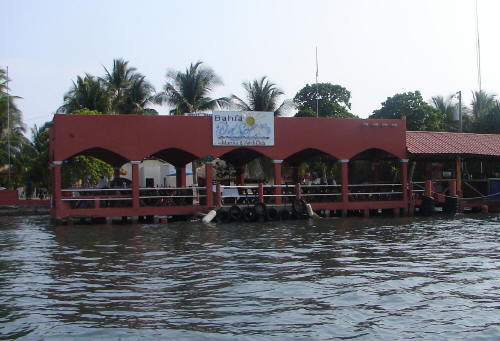
Bahia del Sol Hotel, where we have use of the |
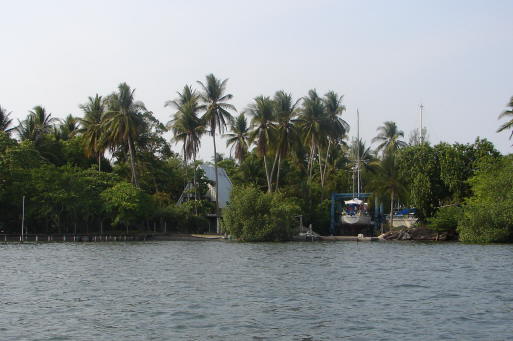
Murray & Colette's home and their |
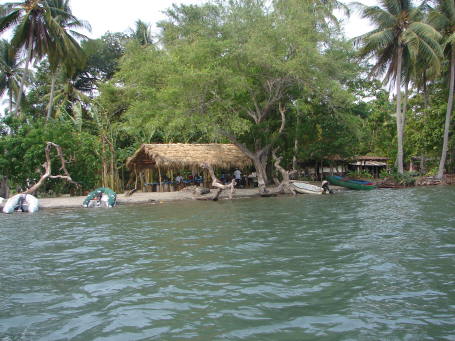
Jan (s.v. Quantum Leap) owns this |
San Salvador
San Salvador is the capital city of El Salvador. It is a fairly large city with a population of 2.1 million in the metropolitan area. It is the country's transportation center, so in order to travel to other cities or countries, we first need to go to San Salvador. (San Salvador is 1½ to 2 hours by bus from Costa del Sol.)
San Salvador is diverse - parts of the city are very modern and feel very much like a U.S. city. In other parts, there is no question that we are in Central America. Many U.S. companies are doing business in San Salvador - lots of retailers and especially restaurants. We expected to see Mc Donald's and Burger King, but Tony Roma's and TGI Fridays surprised us. One doesn't have to look very hard to find a Pizza Hut or Kentucky Fried Chicken.
San Salvador is a great place to shop. They have at least three very modern malls, and their MetroCentro is the largest mall in Central America. With Apple Stores that sell IPods and Nine West shoe stores, the malls are places where we feel like we're in the U.S. The city also has good hardware stores (several of them Ace Hardware) for boat project supplies and a PriceSmart (like Costco). Although it's impossible to carry a bunch of PriceSmart purchases on a bus, we can occasionally catch a ride with a neighbor who has a car and share gas expenses. Cabs are also available but it's an expensive ride back to Costa del Sol.
We've also taken advantage of the excellent and affordable healthcare here. We've visited a dentist to have our teeth cleaned and had some additional physical checkups. From what we can tell, the doctors and other healthcare professionals are well trained and conscientious. Costs are significantly less than in the States. As an example, Jan had a mammogram done for $25.
We haven't done a lot of sightseeing in San Salvador, but we have been through the downtown ("el centro") area, where they have a Central Mercado and large cathedral. In el centro, there's no question that this is Central America. We also visited and enjoyed San Salvador's anthropology museum.
So far, the only tourist site we've visited in El Salvador has been their Parque El Impossible, but we have a couple more places on our next travel itinerary.
Parque Nacional El Imposible (5/31-6/2).
This national park was founded in 1989 and is one of the last tropical forests in El Salvador. It was named for the perilous gorge through which coffee growers once labored to move their crop from the northern farms to the port of Acajutla on the coast. El Imposible covers an area of 5,000 hectares (over 12,000 acres), and it is the largest and most biologically diverse protected area in El Salvador. It is home to over 400 species of trees, 250 species of birds, 100 species of animals and 500-600 different species of butterflies. The butterflies were especially beautiful! The altitude ranges from 300m to 1450m above sea level (1000 to 4500 feet), so it was a bit cooler here than at the coast - a nice break from the heat and humidity.
There is a small "ecolodge" called Hostal El Imposible with five cabins just outside the entrance to the park, and we booked one of the cabins for three nights. We spent a good part of the first day traveling to get there - three chicken bus connections, but all went smoothly. We arrived at the hostel early afternoon. Since we had a very early start from San Salvador that morning, and some light rain showers arrived with us, we took a walk around the grounds of the hostel and spent the afternoon relaxing on the porch of our cabin - listening to the birds, watching the butterflies, reading and napping.
For the next couple of days, we were the only guests at the hostel. The staff, Luis and Carlos (the caretakers) and Marilu (the cook), were incredibly nice and took good care of us. None of them spoke any English, so we had to rely on our Spanish. Our conversations were somewhat limited, but we got by and enjoyed our time with them.
We spent two mornings hiking with a guide Jose. Jose was a young, local guy, who knew every inch of the park and could identify all the plants and animals. Our first day, we hiked to Cerro El Leon, a hill in the middle of the park, which offered beautiful views. The hike was 8 km (about 5 miles), and very little of it was flat, so our legs got quite a workout. The next day we hiked to Los Enganches, a shorter hike which also offered us an opportunity to swim in a river - very refreshing. Along the way, Jose pointed out plants, trees, animals, insects and identified a number of the bird calls for us. We had rain both afternoons, and we enjoyed the downtime on our cabin porch.
This was a delightful trip and one we would highly recommend to El Salvador visitors.
